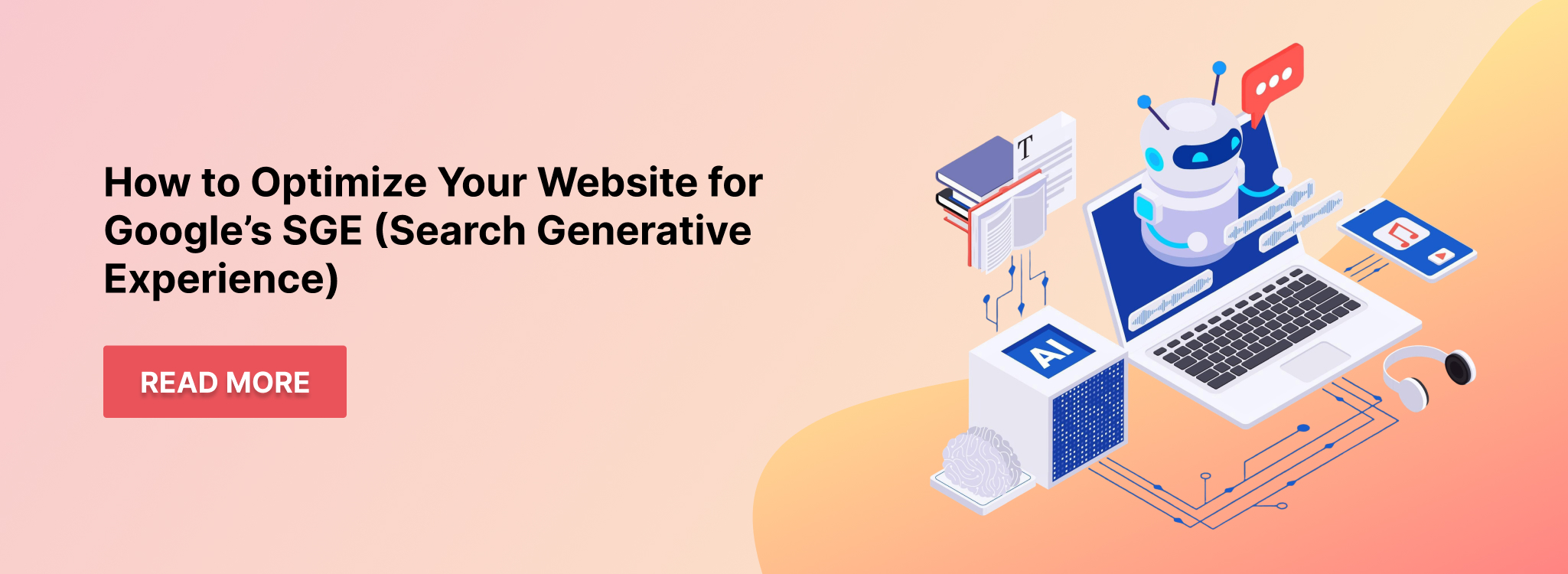How to Optimize Your Website for Google’s SGE (Search Generative Experience)
Recently updated: August 4th, 2025
Search is changing faster than anyone expected. The blue-link model that defined SEO for the past 20 years is being replaced by generative AI experiences – not gradually, but aggressively. This is where Google SGE (Search Generative Experience) enters.
Instead of giving users 10 links to click through, SGE summarizes everything for them at the top of the page. AI answers now dominate the search real estate once ruled by traditional SEO. And if your content isn’t part of that summary box? You’re invisible to the user. So, you should know how to optimize for sge?
That’s the reality for 2025.
1.Why Google SGE SEO Matters in 2025
SGE isn’t just another update. It’s a complete shift in how people find, read, and act on information. And it’s already live for millions.
When a user types, “How to fix a leaky faucet,” or “Best B2B lead gen tools for small agencies“ Google doesn’t just show results. It now writes an answer. An answer that may include your content but only if your website is optimized for it.
And that’s the opportunity.
SGE is creating a new layer of competition. Not for rankings, but for visibility inside AI-generated summaries. The sites that appear there win not just clicks, but trust. And those that miss out? They’re watching their organic traffic drop without understanding why.
Early movers have a clear edge. Just like the brands that figured out mobile-first SEO before their competitors, those who adapt to SGE today are locking in prime real estate in tomorrow’s search ecosystem. This isn’t just about ranking anymore. It’s about being quoted, cited, and summarized by the AI that’s rewriting the rules of search.
2.What Is SGE?

SGE stands for Search Generative Experience, Google’s AI-powered reimagination of how search results are presented. Instead of listing pages and snippets, it creates AI-generated summaries that answer a user’s query directly using a mix of:
- Real-time web data
- Structured content from websites
- Citations pulled from trusted, indexable sources
- Google’s own large language models (LLMs)
It’s not just a cosmetic update. SGE is a fundamentally different interface that prioritizes clarity, speed, and confidence. And the biggest change? Users no longer have to click multiple links to “piece together” an answer, Google does it for them.
So how does it work?
When someone types in a query like “how to reduce employee turnover in small companies,” SGE doesn’t serve ten blue links and a few ads. Instead, it returns:
- A multi-paragraph, AI-generated answer
- A combination of explanations, strategies, and causes
- Embedded source links from high-authority pages it pulled information from
This is what makes SGE different from a ‘featured snippet’ or a “People Also Ask” box. It’s not just pulling from one source. It’s synthesizing information from multiple sources.
Those source links? That’s where your opportunity lies.
Google’s AI uses real web content to generate these answers. If your site has structured data, authoritative content, and matches the query intent well, it can be cited directly inside the AI summary.
SGE also differs from ChatGPT or Perplexity in one key way: it’s tied directly into search. That means your content still needs to be crawlable, indexable, and aligned with core SEO principles, but now it also has to be ready for AI extraction.
And it’s fast evolving.
SGE isn’t limited to text. It’s now pulling in multimedia like videos, images, product cards, and reviews. For queries like “best protein powders for women,” you might see product carousels with AI-generated insights and e-commerce listings right beneath the AI summary.
2.1 SGE’s Impact on Organic Traffic & SERP Behavior
The launch of Google’s SGE isn’t just changing how search looks; it’s rewriting how people interact with it. If you’ve noticed a drop in clicks despite ranking well, this is likely why.
Here’s how SGE is reshaping user behavior and traffic patterns:
- AI summaries now sit above traditional results: The generative answer box often taking up the top 25–40% of the page, pushes classic organic links further down. Fewer users scroll past it.
- Users get answers without clicking: With a few lines of AI-generated text summarizing the topic, many users feel satisfied without visiting a single page. This creates a new form of zero-click search.
- Traditional CTR is declining fast: Even first-page rankings are seeing reduced traffic. Some reports show a 20–30% drop in organic click-through rates for certain informational queries.
- SGE citations are the new top rankings: Instead of fighting for position #1, websites now compete to be linked or referenced in the AI summary. That link embedded in a trustworthy AI answer is today’s highest visibility slot.
The shift in SERP behavior is clear:
- People are scanning fewer links.
- They’re trusting AI-generated overviews more.
- They’re clicking only when they want to go deeper, which makes those clicks even more valuable.
Why this matters for your website:
If your content isn’t part of the AI summary or at least linked within it, your visibility is already shrinking. SGE doesn’t replace SEO, but it does layer a new level of competition on top of it.
3. SEO, AEO & GEO: The New Optimization Trinity

Optimizing for Google SGE isn’t about abandoning SEO; it’s about expanding it.
To win in a search environment led by generative AI, websites now need to balance three distinct but connected disciplines:
- SEO (Search Engine Optimization): The technical and content foundation. Without it, nothing else gets crawled or ranked.
- AEO (Answer Engine Optimization): The formatting strategy. Designed to help your content appear inside direct AI summaries.
- GEO (Generative Engine Optimization): The authority layer. Focused on building the reputation and credibility needed to be cited by AI models.
Why this trinity matters:
- Traditional SEO still gets you indexed and ranked.
- AEO makes your content quote-ready for AI overviews.
- GEO tells the AI your brand is trustworthy enough to recommend.
SGE sits on top of all three, and if even one layer is missing, you’re less likely to show up in those all-important AI answer boxes.
3.1 Generative Engine Optimization (GEO) for AI Citation Authority
If AEO helps your content get summarized, Generative Engine Optimization (GEO) helps it get cited. GEO is about building the authority, structure, and credibility that Google’s generative models look for when deciding what to reference inside an AI answer. SGE doesn’t pull random quotes. It pulls from what it trusts.
So how does Google decide what’s citation-worthy?
- Topical Authority: Your site needs to cover a topic in depth. One article isn’t enough. SGE favors domains that publish consistently within a niche and demonstrate subject matter expertise over time.
- EEAT (Experience, Expertise, Authoritativeness, Trustworthiness): This is core to how AI systems judge content. You need:
- Named authors with bios
- Clear editorial structure
- Citations to external, credible sources
- Updated content that reflects current standards
- Structured Data Markup: Adding schema isn’t just for rich results. It tells Google what your content is, who created it, and how it’s organized. The more clearly defined your pages are, the easier it is for SGE to use them.
- Consistent Entity Signals: If your brand or author appears in Knowledge Panels, Google Scholar, expert directories, or Wikipedia, those are strong credibility markers for AI models. They signal that your site is part of a trusted network.
GEO success relies on three key layers:
- Content layer – Publish expert-led, semantically organized content.
- Metadata layer – Use schema to describe everything (article, author, business).
- Reputation layer – Build digital presence beyond your website (mentions, links, bios, and citations).
4. SGE SEO Best Practices: On Page Strategy
Now that you understand how SEO, AEO, and GEO work together, it’s time to put that knowledge into practice. SGE optimization doesn’t happen by accident. It requires a deliberate, page-by-page strategy built on content design, technical hygiene, and structured layout.
This is where most businesses fall short.
They write good content, but it’s not structured for extraction. Or they answer the right questions, but don’t format them in a way Google’s generative model can digest. Some don’t include schema or author bios and get ignored for lack of authority.
To succeed in the new AI-powered search world, your on-page content needs to do all of the following:
- Align with conversational intent
- Be structurally scannable and semantically clear
- Reinforce topical expertise and authority
- Perform technically (speed, schema, mobile, etc.)
In the next five subsections, we’ll walk you through the exact on-page tactics that make your content SGE-ready, starting with keyword intent.
4.1 Keyword Research & Intent Mapping for Generative Search
In the SGE world, keywords still matter but not in the way they used to.
Traditional SEO focused on matching keywords to search queries. Generative SEO requires matching your language to the way people ask questions conversationally because that’s exactly how AI models interpret and summarize your content.
If you’re still targeting generic head terms like “content marketing” or “healthy snacks” ,you’re not SGE-ready.
What works now: long-tail, intent-rich, conversational queries.
SGE optimization starts with researching and writing for:
- Natural questions: Think:
- “What are the best budget cameras for vlogging?”
- “How to build muscle without going to the gym?”
These resemble actual prompts people type into Google and now into SGE.
- Voice search-style phrasing: People talk to Google differently than they type. Your keywords need to mirror that casual tone.
- Instead of: “freelance invoice template”
- Try: “How do I create an invoice as a freelancer?”
- Situational modifiers: SGE loves contextual queries. Include words like:
- “for beginners”
- “under $50”
- “in summer”
- “without XYZ”
These modifiers help narrow relevance and trigger better matches with AI summaries.
How to map keyword intent for SGE:
- Start with the user’s real question: Tools like AnswerThePublic, AlsoAsked, and Google’s own “People Also Ask” section can spark real query ideas.
- Use semantic keyword clusters.: Group related long-tails into a content set. For example:
- Main topic: “meal prep for weight loss”
- Cluster: “cheap healthy meal prep,” “easy recipes,” “how to prep for the week”
- Avoid robotic keyword stuffing.: Google’s LLMs are smart enough to understand meaning without repetition. One clear, natural mention is more valuable than five awkward insertions.
Example: Old vs New Keyword Targeting
| Traditional SEO Target | SGE-Optimized Target |
| “Best laptops” | “Best laptops for college students under $600” |
| “Time management tools” | “What tools help remote teams manage time better?” |
| “Marketing tips” | “How to market a small business on a low budget” |
These changes might seem small but they completely reshape how your content aligns with AI interpretation. Generative models respond to human-like input. So, your pages need to be written like answers to real human questions.
4.2 Structured Content: Headers, FAQ, and Snippet Optimization
You could write the most insightful article on the internet, but if it isn’t structured properly, Google’s generative AI won’t know how to use it.
SGE pulls content that is scannable, sectional, and easy to summarize. This is where formatting becomes just as important as the words themselves.
Here’s how to structure your content for maximum SGE visibility:
- Use Clear, Logical Header Hierarchies (H2, H3, H4)
- Think of your headers like chapter titles; they guide both readers and AI through your page.
- Start with H2s for major sections (questions or key ideas), then break down into H3s or H4s for supporting detail.
Example:
H2: What are the benefits of cold showers?
H3: Improves circulation
H3: Reduces muscle soreness
This format makes it easy for SGE to find and group your points into a paragraph or bullet list.
- Optimize for Featured Snippet-Style Answers
Write summary-style text directly under each question or heading – 2 to 4 sentences is the sweet spot.
SGE pulls clean answers like this:
“Cold showers can improve circulation, reduce inflammation, and boost alertness. They’re also linked to improved mental resilience over time.”
Avoid fluff. Write like you’re answering someone in a forum thread – helpful, clear, and fast.
- Add Dedicated FAQ Blocks on Every Page
- Use real, search-driven questions users are asking.
- Keep each answer under 100 words.
- Use bullets or numbered steps if possible.
- Format for Skimmability

Use:
- Short paragraphs (2–3 lines max)
- Bullets and numbered lists
- Highlighted key terms in bold or italics (when appropriate)
- Spacing between ideas
The easier your content is to skim, the easier it is to summarize.
Generative search doesn’t just reward what you say; it rewards how cleanly you say it.
If you want to be cited, structured content is your ticket in. Treat every page like a blueprint: logically outlined, easy to digest, and visually segmented.
4.3 EEAT & Authority Signals
It’s not just about what your content says; it’s about who’s saying it and why Google should trust it.
That’s where EEAT comes in: Experience, Expertise, Authoritativeness, and Trustworthiness. These aren’t just Google quality guidelines anymore; they’re key factors SGE uses when deciding what content to pull into its AI summaries.
SGE doesn’t want to cite anonymous blogs or vague articles. It wants to highlight experts, credible sources, and content with proof.
Here’s how to build strong EEAT signals into your content:
- Add Author Bios With Relevant Credentials
- Include a short bio at the top or bottom of each article.
- Highlight the author’s experience or qualifications related to the topic.
- Link to their LinkedIn, credentials, or published work.
Example: Written by Sarah Malik, Registered Nutritionist with 8+ years of experience in sports and clinical dietetics.
This shows Google (and users) that the content comes from a real person with subject authority.
- Use Citations and Expert Quotes
- Link to high-quality external sources: .gov, .edu, research papers, trusted publications.
- Quote recognized experts when applicable.
- Use inline references where stats or claims are made.
This boosts your authority and makes your page more citation-friendly for SGE summaries.
- Include Trust Signals on Your Site
- Add About, Contact, and Privacy Policy pages.
- Display testimonials, certifications, and media features.
- Include physical address or business info if relevant.
Even if these don’t live on the article page, they influence your site’s overall trustworthiness in Google’s eyes.
- Keep Content Fresh and Factually Accurate
- Outdated stats or dead links = trust downgrade.
- Revisit older blog posts regularly to update facts, pricing, or strategies.
- Add “Last updated” timestamps to signal freshness.
SGE prefers quoting current sources over ones that feel stale, even if the URL is the same.
In a world where AI is the middleman, human credibility is your differentiator. If SGE doesn’t see clear signals that your content is written by someone who knows what they’re talking about, it won’t use it – no matter how well-written it is.
4.4 Visual Content & Multimodal Optimization
SGE isn’t just reading your words; it’s scanning your visuals too.
Google’s generative results are becoming increasingly multimodal, which means they incorporate images, video previews, infographics, and even audio when generating answers. If your content only relies on text, you’re missing a major opportunity to stand out.
SGE pulls media from sources it trusts and those that follow optimization best practices.
Here’s how to get your visual content SGE-ready:
- Use Descriptive, Semantic Alt Text
- Don’t leave alt text blank or generic.
- Write specific, functional descriptions that reflect real user queries.
Bad alt text: image1.jpg
Good alt text: infographic showing 5 high-protein breakfast options under 300 calories
SGE uses alt text as a cue to decide whether to display your image in a generative answer block.
- Embed Informative, Branded Infographics
- Summarize processes, lists, or stats visually.
- Use clear labels, consistent fonts, and include your brand subtly in the design.
- Add a keyword-rich caption or description nearby.
Infographics are easily digestible by AI and often favored in “visual answers” for queries like “how to compost at home” or “email marketing funnel stages.”
- Optimize Video Metadata and Placement
- Embed short videos with transcriptions.
- Title them using natural, question-style phrasing like:
- “How to tie a tie (Step-by-Step)”
- “What is the keto diet? Explained in 60 seconds”
Also:
- Add schema.org/VideoObject markup.
- Include a written summary below the video, Google still needs text to parse meaning.
- Add High-Quality Product or Concept Images
For eCommerce or educational content:
- Use original, high-res images (avoid generic stock photos).
- Compress for speed, but retain clarity.
- Include dimensions, context, or use cases in captions.
This improves AI’s understanding and makes it more likely your images appear in visual snippets or shopping cards inside SGE panels.
If your content looks good, loads fast, and explains something clearly, SGE will notice and may feature your media alongside the text. Optimizing for SGE isn’t just about being read. It’s about being seen, shown, and summarized in every format the AI supports.
4.5 Technical & Speed Optimization
Google’s generative engine isn’t going to wait around for your site to load. Neither will users.
SGE chooses sources that are not only informative and trustworthy, but also technically performant. If your page is slow, bloated, or messy under the hood, you’re far less likely to be included in AI summaries, no matter how great your content is.
Here’s how to stay lightning-fast and LLM-friendly.
-
Optimize for Core Web Vitals
SGE favors pages that pass Google’s Core Web Vitals, especially:
- LCP (Largest Contentful Paint): Should load in under 2.5 seconds
- CLS (Cumulative Layout Shift): Keep unexpected layout shifts to a minimum
- FID/INP (Input Delay): Minimize lag between click and response
Use PageSpeed Insights to monitor and fix these regularly.
-
Streamline Code and Scripts
- Minimize CSS and JavaScript bloat
- Defer or lazy-load non-critical scripts
- Avoid excessive plugins or third-party tools that slow things down
Less code = faster page load = more AI inclusion.
-
Use LLms.txt and Robots.txt Smartly
Just like robots.txt tells crawlers what to index, LLMs.txt (a new standard) is being explored as a way to guide large language models.
Best practice:
- Keep robots.txt open for Googlebot and known AI agents (like Google-Extended)
- Use LLMs.txt (when officially adopted) to signal preferred pages or exclusions
And always allow AI access to important content like:
- Product pages
- Blog posts
- FAQ sections
- Resource libraries
-
Compress and Serve Optimized Images
- Use WebP or AVIF for faster loading
- Set proper dimensions to reduce layout shifts
- Lazy-load below-the-fold images to cut initial load time
Pro tip: Even small image savings can trim hundreds of milliseconds off your page speed.
-
Prioritize Mobile Usability
- Use responsive design, no pinch/zoom or horizontal scrolling
- Ensure buttons and CTAs are tap-friendly
- Simplify popups or interstitials that interrupt the user experience
SGE results often show on mobile-first interfaces, especially for voice and assistant-driven queries. You can’t afford to ignore the small screen.
Fast pages don’t just convert better; they get cited more often by AI systems looking for seamless user experiences. SGE might feel like a content game, but speed is the gatekeeper. If your site’s too slow, you’ll never make it to the summary box.
5. SGE Ranking Levers: Off Page & Authority Building
 So far, we’ve focused on what you control directly – your content, your structure, your speed. But Google’s SGE doesn’t make citation decisions based solely on your site. It also weighs what the rest of the web says about you.
So far, we’ve focused on what you control directly – your content, your structure, your speed. But Google’s SGE doesn’t make citation decisions based solely on your site. It also weighs what the rest of the web says about you.
This is where off-page SEO blends into SGE optimization. It’s not just about getting backlinks for rankings anymore; it’s about earning trust, recognition, and visibility across the broader digital ecosystem.
SGE isn’t citing you in a vacuum.
It’s asking questions like:
- “Is this domain mentioned elsewhere in authoritative contexts?”
- “Has this expert contributed to trusted platforms?”
- “Is this brand known within its industry?”
- “Is this page linked to by reputable sources?”
If the answer is yes, your odds of being included in generative answers skyrocket. Generative search is shaped by off-page signals just as much as on-page ones.
5.1 Backlink Strategy for Generative Citations
Backlinks have always mattered, but with SGE, their role has evolved. It’s no longer just about Domain Authority or anchor text. Now, the question is:
“Would a generative AI model trust this source enough to cite it?”
SGE is citation-driven. And most citations come from content that’s already mentioned or linked across trusted parts of the web. That’s why your backlink strategy needs to shift from quantity to quality, context, and credibility.
Here’s how to earn the kind of backlinks SGE values:
- Prioritize Reputable Mentions
- Focus on getting linked by:
- Industry news sites
- Government or educational resources
- High-authority blogs or SaaS providers
- Avoid shady directories, low-effort guest posts, or link swaps; SGE ignores or downranks these.
Example: Getting linked in a HubSpot blog roundup or an Ahrefs study will go a lot further with AI than a random backlink from a new niche site.
- Use Digital PR and Outreach
- Pitch original research, data, or case studies to journalists and bloggers.
- Build stories that are worth linking to, not just “SEO content,” but narratives that add something new.
- Create Highly Linkable Assets
- Publish content others want to reference:
- Data visualizations
- Industry benchmarks
- Expert-led whitepapers
- Interactive tools or calculators
- Focus on Contextual, Relevant Linking
SGE evaluates where your link is placed, not just whether it exists.
Links inside:
- body content of long-form articles
- expert roundups
- instructional content
…carry more weight than footers, author bios, or sidebar widgets.
Avoid link spam at all costs.
SGE-trained models can sniff out artificial patterns. They’re more likely to cite content from a site with fewer high-quality backlinks than one with thousands of junk links.
In the AI world, it’s not about how many people talk about you, it’s about who does.
Want to show up in summaries? Build a backlink profile that screams credibility, not manipulation.
5.2 Google Knowledge Graph & External Signal Optimization
One of the fastest ways to gain SGE visibility? Get your brand or content recognized by Google’s wider ecosystem, especially the Knowledge Graph.
Why? Because when SGE needs a trustworthy source to cite in an AI summary, it often pulls from known entities – people, businesses, or sites it already understands.
The Knowledge Graph helps Google “connect the dots” about who you are, what you offer, and how you relate to other entities online. The more visible you are across trusted corners of the web, the more likely you’ll be referenced by AI.
What counts as an external trust signal?
- Wikipedia pages or citations
- Mentions in reputable media
- Verified Google Business Profile (for local)
- Wikidata entries
- Author bios across multiple domains
- High-authority backlinks
- Inclusion in structured directories (Crunchbase, LinkedIn, Google Scholar, etc.)
Here’s how to strengthen your external signal profile:
- Get Listed in Structured, Public Databases
- Add or claim a Wikidata entry – this feeds directly into the Knowledge Graph
- Complete your Google Business Profile, especially if you’re a local business or service provider
- Ensure consistency across all listings (same brand name, description, links)
- Contribute Content to Trusted Domains
- Write guest articles for industry-leading blogs
- Get quoted in high-authority publications (via digital PR or HARO)
- Participate in expert panels, podcasts, or webinars that are indexed
These actions build a digital footprint that Google’s AI can trace and trust.
- Strengthen Semantic Relationships
Use structured data on your own site to clarify relationships between:
- Your brand and your founders (Organization + Person schema)
- Your authors and their expertise (Author schema)
- Your site and your social media, awards, or affiliations
Example:
json
CopyEdit
“sameAs”: [
“https://linkedin.com/in/yourname”,
“https://twitter.com/yourhandle”,
“https://en.wikipedia.org/wiki/Your_Company”
]
This markup tells Google that all these profiles are the same entity and that your brand has depth.
- Monitor and Correct Knowledge Panel Data
- If you already have a Knowledge Panel (search your brand or name), check it for accuracy
- Use Google’s feedback links to suggest edits or corrections
- Consolidate duplicate profiles or inconsistencies that could weaken your entity profile
The more Google understands you, the more confidently its AI can recommend you. Don’t treat off-site presence as an afterthought in the SGE world, it’s one of your most valuable ranking signals.
5.3 Social & Multimedia Presence
 SGE isn’t just reading your blog or product pages. It’s pulling from a broad, multimedia internet, and if your brand doesn’t exist across platforms like YouTube, podcasts, and social media, you’re less likely to be part of the conversation.
SGE isn’t just reading your blog or product pages. It’s pulling from a broad, multimedia internet, and if your brand doesn’t exist across platforms like YouTube, podcasts, and social media, you’re less likely to be part of the conversation.
Generative AI models are multimodal learners. They recognize, weigh, and sometimes cite content from videos, community forums, and public conversations, not just websites.
That’s why building a strong presence across social and multimedia platforms isn’t just branding anymore. It’s SGE optimization.
-
YouTube: The Visual Answer Engine
YouTube is one of Google’s favorite content sources, especially for:
- Tutorials (“how to…”)
- Reviews and comparisons
- Topic deep-dives
To optimize:
- Use natural-language video titles (e.g., “How to Use Google Search Console for SEO in 2025”)
- Write keyword-rich video descriptions and include timestamps
- Add VideoObject schema if you embed videos on your site
Bonus: Videos are now showing up in SGE overviews, especially when paired with transcript summaries.
-
Forums, Q&A Platforms, and Niche Communities
AI regularly pulls context from:
- Reddit (especially r/SEO, r/marketing, r/ecommerce)
- Stack Exchange or Quora
- Industry-specific communities (like Indie Hackers or Dev.to)
How to leverage:
- Answer questions authentically with links to helpful resources (not self-promo)
- Share real expertise, AI can detect fluff vs. substance
- Monitor mentions of your brand or name
If SGE detects patterns of trust or expertise around your contributions, it may reflect that in citations or brand visibility.
-
Social Media Authority
SGE doesn’t use follower counts but it does observe consistency and recognition. Brands that:
- Post regularly
- Are mentioned by other known accounts
- Appear in trending or expert-driven threads
…build stronger entity profiles.
Use platforms like LinkedIn and X (formerly Twitter) to:
- Share original thoughts or key takeaways from your content
- Link to blog posts, product updates, and expert insights
- Comment on trending industry topics to stay visible
SGE visibility isn’t just about writing; it’s about showing up where people already talk, watch, and learn.
The more channels you appear in and the more your message stays consistent the more likely you are to be picked up and referenced by generative AI.
6. Content Formats That Win in SGE Overviews
 Not all content is created equal, especially in the eyes of SGE.
Not all content is created equal, especially in the eyes of SGE.
Google’s generative model pulls from content that isn’t just well-written, but format-ready. If your article or landing page is laid out like a textbook, it’s less likely to make the cut. If it’s structured like a helpful answer or expert guide? Much higher odds.
SGE favors formats that:
- Are easy to summarize
- Include structured, layered information
- Reflect real-world queries and user needs
In short: content that looks like something someone would ask for.
Whether you’re writing a blog, building a landing page, or updating a help doc, the format you choose plays a huge role in how your content gets read and whether it gets featured.
6.1 Pillar Pages & Topic Clusters
SGE loves depth. And few content formats deliver that better than pillar pages backed by a structured topic cluster.
In traditional SEO, this format builds internal linking and topical relevance. In SGE, it does something more: it signals to Google that you’re not just publishing content; you’re owning a subject.
What is a Pillar Page?
A pillar page is an in-depth, high-level resource covering a broad topic. It links out to related subtopics (the “cluster”), which each dive deeper into a specific angle.
Example: A pillar page titled “The Complete Guide to Remote Work in 2025” might link out to:
- “Best Time Tracking Tools for Remote Teams”
- “How to Set Boundaries While Working from Home”
- “Creating a Remote Company Culture That Lasts”
Each of those cluster pages links back to the main pillar, forming a web of semantic relevance.
Why SGE loves this format:
- AI can pull summaries from multiple angles: The cluster structure gives SGE a buffet of concise, specific answers tied to one core domain.
- Stronger topical authority = higher trust: Google sees a site with 10 well-linked articles on remote work as more credible than one page trying to cover it all.
- Easier citation and linking: Shorter cluster posts are often cleaner for AI to quote, while the pillar builds context and authority.
How to Build an SGE-Optimized Topic Cluster:
- Start with a search-friendly core topic: Choose something broad enough to support 6–10 subtopics. (e.g., “Email Marketing,” “Meal Prep,” “Freelancing in Dubai”)
- Map the real user questions: Use tools like AlsoAsked or People Also Ask to find natural subtopics:
- “Best email subject lines for cold outreach”
- “When is the best time to send newsletters?”
- Write subpages that answer each one cleanly: Use Q&A structure, headers, and schema (see Section 4.2 for structure tips)
- Link everything together: Use contextual anchor text. Don’t just say “click here.” Instead:
- “Explore our full list of tools for remote collaboration”
- “Learn how freelancers in the UAE invoice international clients”
Pro Tip: Keep Clusters Fresh
SGE responds well to up-to-date pages. Set a quarterly reminder to:
- Add new subtopics based on trending questions
- Refresh stats or product links
- Reoptimize for speed and structure
One page doesn’t build trust. But a well-linked cluster? That makes you a go-to source.
6.2 FAQs, Quick Answers, Data-Led Highlights
 SGE is built to serve users fast, direct information. So the more your content mirrors that format – short, focused, and structured – the more likely it is to be pulled into a generative answer.
SGE is built to serve users fast, direct information. So the more your content mirrors that format – short, focused, and structured – the more likely it is to be pulled into a generative answer.
This is where micro-content formats shine.
They’re not full blog posts or in-depth guides. They’re small, sharp blocks of content that answer questions quickly and clearly.
-
FAQs That Match Real Search Prompts
Adding a dedicated FAQ section to every key page isn’t optional anymore, it’s essential.
Here’s how to do it right:
- Use natural question formats (e.g., “What’s the difference between probiotic and prebiotic?”)
- Keep answers tight, ideally under 100 words
- Link to supporting content when relevant
-
Answer Blocks at the Top of Each Section
Right after every H2 or H3, place a short, polished summary. Think of it as a TL;DR version of what the section explains.
Example:
H2: How long should I intermittently fast?
A common intermittent fasting schedule is 16:8 – 16 hours of fasting followed by an 8-hour eating window. Other options include 14:10 or 5:2.
This format makes it easy for SGE to identify useful answers before diving into the longer explanation.
-
Data Highlights and Stats with Context
SGE loves content backed by data, especially when it’s easy to extract and quote.
Use formats like:
- “85% of freelancers say they prefer asynchronous communication.”
- “Average website load time for top-ranking pages is 2.3 seconds.”
- “In 2024, over 60% of mobile users abandoned sites that took over 3 seconds to load.”
When you provide stats with relevance (and preferably a citation), AI will often favor your page over more generic explanations.
Bonus Tip: Use Visual Cues
Even when using text, break things up with:
- Bullets
- Numbered lists
- Highlighted terms
- Emoji (when stylistically appropriate, especially in B2C)
While SGE doesn’t display emojis, it does reward visual clarity and easy-to-parse formatting behind the scenes. Think of SGE like a time-pressed reader. If your content helps them skip the scroll and find the answer fast, you’ll get featured.
6.3 Case Studies and Quantified Evidence
SGE doesn’t just want opinions; it wants proof.
Generative AI pulls from content that offers credible outcomes, numbers, and real-world examples. Why? Because those are harder to fake and easier to cite.
If your site features case studies, success stories, or statistically backed claims, you’re already ahead of most publishers still writing in generalities.
Why Case Studies Matter for SGE
- They demonstrate authority through experience
- They include measurable before/after results
- They often feature named entities (clients, tools, locations), which SGE uses to validate context
Example:
“After switching to our CRM, Acme Inc. reduced lead response time by 37% in three months.”
SGE can cite that as a data point and link to your content as the source.
Other Formats That Work Like Case Studies
Even if you don’t have clients or users to showcase, you can still publish:
- Tutorials with measurable outcomes: “How we ranked a new page in SGE in under 2 weeks”
- Benchmark reports: “Top 10 SEO tools ranked by site speed impact”
- Product comparisons: “Trello vs. Asana: Real project data from 3 teams”
All of these work well because they offer evidence, not just insight. If your content helps users predict real outcomes, SGE sees you as more than informative, it sees you as useful. That’s the kind of source Google’s AI likes to recommend.
7. Monitoring & Optimization: Track SGE Performance
 Once you’ve optimized your content for SGE, how do you know it’s working?
Once you’ve optimized your content for SGE, how do you know it’s working?
That’s where performance tracking comes in.
And the old SEO metrics like rankings and impressions won’t tell you the full story anymore. SGE traffic behaves differently, appears under different parameters, and may not show up in your usual dashboards unless you’re looking for the right signals.
7.1 Analytics Beyond CTR: Citation Frequency & AI Traffic
SGE traffic is stealthier than traditional search clicks but it’s trackable.
How to monitor it:
- Look for UTM tags from generative engines
- Some AI platforms (like ChatGPT) append utm_source=chatgpt.com
- Monitor for similar referral tags from search.google.com, especially on mobile
- Check server logs for LLM-related crawlers
- Google-Extended (used for Bard/Gemini and SGE)
- ChatGPT or OAI-SearchBot
- PerplexityBot, YouBot, etc.
- Set up GA4 event tracking on CTA clicks: See which pages are generating downstream engagement, even if the initial session came via a non-click SGE mention.
7.2 Content Audits & Refresh Strategy
SGE doesn’t just care what you published; it cares how current it feels.
Here’s how to keep your AI-optimized content fresh and usable:
- Quarterly audit your top AI-priority pages: Look for:
- Broken links
- Outdated stats
- Shifts in user intent (based on “People Also Ask” trends)
- Update publish dates only if meaningful edits were made. Google may deprioritize content with misleading freshness signals.
- Reinforce internal links to updated pages so crawlers rediscover them quickly
- Monitor FAQs and add new questions based on evolving queries from forums or Reddit
Keeping things fresh doesn’t just help SEO; it ensures SGE doesn’t overlook your page in favor of newer sources.
7.3 Testing and Experimentation
SGE is still evolving. So your strategy should be too.
What to test:
- Different Q&A formats
- Full paragraph vs. bullet answers
- First-person tone vs. neutral/expert tone
- Schema variations
- Try adding FAQPage, HowTo, VideoObject, or combining Organization + Author for layered credibility
- Answer position testing
- Move summary blocks to the top vs. bottom of sections to see which gets more citations
- Media vs. no media
- Does adding a video summary improve visibility in SGE’s visual panels?
How to measure impact:
- Create A/B content variants using tools like Google Optimize or Webflow’s native AB testing
- Track changes in:
- Referral volume
- Scroll depth
- CTA clicks
- Average time on page
Generative SEO isn’t set-and-forget; it’s a feedback loop.
The more you monitor and test, the better you’ll understand what SGE is rewarding and where to double down.
8. Industry-Specific Applications: Ecommerce, Local & B2B
SGE doesn’t treat all websites the same.
Depending on your industry, the way you show up in AI-generated answers and the type of content you should prioritize will look different. Ecommerce sites need product-level visibility. Local businesses need geographic relevance. B2B brands need depth and trust.
8.1 Ecommerce & Product Pages for AI Shopping Results
Ecommerce brands are on the front lines of SGE because generative results are starting to replace traditional shopping carousels.
To win product visibility inside these overviews, your product pages must be structured, image-rich, and schema-driven.
What to optimize:
- Product schema (Product, Offer, AggregateRating)
- Detailed descriptions with use-case language
- Instead of “Red Cotton T-Shirt,” use:
- “Breathable red cotton t-shirt for summer workouts – lightweight, sweat-wicking, soft feel”
- Instead of “Red Cotton T-Shirt,” use:
- Pricing and availability metadata
- Alt text on product images
(“women’s trail running shoes – lightweight, waterproof, black”) - Include reviews and ratings as structured data
These often appear in SGE product summaries.
Bonus:
Use buyer intent keywords on PDPs:
- “best gifts for teens under $25”
- “eco-friendly shampoo for sensitive scalp”
These types of queries are more likely to trigger SGE shopping results, not just standard SERPs.
8.2 Local Business Optimization for SGE
 For brick-and-mortar or service-based businesses, visibility in SGE means showing up in geo-specific generative answers like:
For brick-and-mortar or service-based businesses, visibility in SGE means showing up in geo-specific generative answers like:
- “Best vegan cafes in Jumeirah, Dubai”
- “Affordable pest control near me”
What to prioritize:
- Google Business Profile (GBP) – fully optimized
- Add hours, phone, services, and real Q&As
- LocalBusiness schema
- Include address, geo, openingHours, sameAs, telephone
- Create location-based content
- e.g., “How to choose a wedding photographer in Dubai Marina”
- Include local landmarks, service areas, and directions
- Collect and feature real customer reviews
Bonus: Add review snippets to service pages using schema
SGE often blends map results and generative content. If your business has no local markup, it gets left out of the conversation.
8.3 B2B & Educational Websites
SGE leans heavily on trust for B2B and knowledge-based queries.
That means your site needs:
- Expert-level content
- Clear author credentials
- In-depth guides
- Real-world data
Best practices:
- Write long-form “how-to” and explainer pages
- Use sections like:
- “What is…”
- “Why it matters”
- “Step-by-step implementation”
- Use sections like:
- Cite real sources (Google Scholar, industry whitepapers)
- Add author bios with credentials
- Highlight certifications, experience, or client roles
- Use organizational markup: Let Google know your business has a footprint such as awards, locations, history, social links
- Answer industry-specific questions
- “What is SOC 2 compliance?”
- “How to run a cold email campaign without getting flagged?”
SGE respects subject-matter depth, structured content, and geographic relevance, but the exact mix depends on what you sell, where you operate, and who you serve.
9. Risks & Challenges to Avoid in SGE SEO
 SGE opens up major opportunities, but it also introduces new risks.
SGE opens up major opportunities, but it also introduces new risks.
Generative search is more sensitive than traditional SEO. You’re no longer just optimizing for an algorithm; you’re creating content that could be quoted, summarized, and trusted by an AI. And that means certain tactics that used to fly under the radar can now tank your chances of visibility.
Here’s what to watch out for and how to steer clear of SGE landmines.
-
Keyword Stuffing in AI-Targeted Content
SGE is trained in natural language. It expects content that sounds like people speak, not robotic keyword repetition.
Bad: “Best hiking boots hiking boots for hiking in the mountains”
Better: “Looking for hiking boots that handle rocky trails and long-distance climbs? Here’s what to look for.”
Fix it: Use long-tail phrases once or twice where they fit naturally. Focus on clarity, not density.
-
Overusing AI to Generate Content at Scale
Ironically, Google’s AI doesn’t reward AI-generated spam.
- If your site uses mass-produced content with no depth, no unique voice, and no structure, it won’t get cited.
- Worse, if it gets flagged as low-quality AI content, it may be actively deprioritized.
Fix it: Use human editing. Add real insights, quotes, experience, and formatting. If your content reads like a tool churned it out in five minutes, SGE will skip it.
-
Ignoring Schema or Blocking AI Bots
Many sites unknowingly kill their own visibility by:
- Blocking Google-Extended or other LLMs in robots.txt
- Skipping structured data
- Failing to update sitemaps
Fix it: Check your robots.txt. Include schema markup for everything (articles, products, videos, FAQs). Make sure your pages are indexable and discoverable.
-
Publishing Without a Clear Author or Expertise Signal
SGE doesn’t want anonymous blog posts. It wants expert-driven content and it needs signals to verify that expertise.
Fix it: Add author bios. Link to their credentials, work, and public profiles. Use schema (Person, Organization, Article) to connect them clearly.
-
Writing for SEO, Not the User
SGE prioritizes usefulness not tricks.
If your content:
- Buries the answer
- Feels repetitive
- Doesn’t solve the actual query
…it’s not getting featured, no matter how “optimized” it looks.
Fix it: Lead with value. Put answers up top. Break things down. Format for humans and machines.
The golden rule: If your content helps a human, SGE will likely find it helpful too. If it’s designed to game the system, it won’t survive.
10. Conclusion & Actionable SGE Optimization Checklist
 SGE isn’t a trend. It’s the start of a seismic shift in how the internet is organized, discovered, and trusted. We’re already seeing AI move beyond static results and into personalized answers, real-time feeds, voice interfaces, and even autonomous agents that can take action on your behalf.
SGE isn’t a trend. It’s the start of a seismic shift in how the internet is organized, discovered, and trusted. We’re already seeing AI move beyond static results and into personalized answers, real-time feeds, voice interfaces, and even autonomous agents that can take action on your behalf.
What does that mean for your site, your strategy, and your content?
It means the future of search is AI-first. And staying ahead means treating SGE not as a feature but as the new foundation.
SGE has changed the rules. What used to be a game of ranking is now a game of being cited, summarized, and surfaced by AI.
The winners in this new search economy aren’t necessarily the biggest brands, they’re the ones who adapt fastest. And now that you understand how to optimize for sge, how to show up in it, and what content formats it prefers, you’ve got the edge most businesses don’t even realize they’re missing.
This isn’t about chasing the algorithm. It’s about building content that answers, teaches, earns trust, and gets used.
So, here’s your next step: act.
SGE Optimization Checklist
Use this to audit your site or guide your next content sprint.
On-Page Content
- Use long-tail, conversational keywords
- Start each section with a clear, direct answer
- Structure with proper H2/H3s and bulleted lists
- Include FAQ blocks and summary paragraphs
- Add schema: FAQPage, HowTo, Article, Product, Author, etc.
- Embed infographics or video with transcripts + alt text
Technical Setup
- Optimize Core Web Vitals (LCP, CLS, INP)
- Enable Googlebot, Google-Extended, OAI-SearchBot in robots.txt
- Compress images, lazy-load non-critical assets
- Use clean, mobile-first design
- Submit structured sitemaps regularly
EEAT & GEO Signals
- Add expert author bios with links to profiles
- Cite external data and trusted publications
- Use sameAs schema to connect profiles, social, and mentions
- Update outdated content and refresh stats quarterly
Off-Page Authority
- Build links from high-authority domains
- Appear on podcasts, webinars, industry roundups
- Publish case studies and real-world results
- Get listed in directories (Wikidata, Crunchbase, etc.)
Monitoring
- Track utm_source=chatgpt.com and similar
- Watch server logs for LLM crawlers
- Set up GA4 event tracking for AI-driven content
- Test different Q&A formats and CTA placements
The faster you adapt to SGE, the faster you’ll own space your competitors don’t even see yet. The next phase of search is already here. Get cited. Get summarized. Get found in the results that matter most.
Frequently Asked Questions
1. What is Google’s SGE (Search Generative Experience)?
Google’s SGE is an AI-powered search feature that delivers quick, conversational summaries at the top of search results. It aims to help users understand topics faster by pulling in key information from multiple sources in real time.
2. How does SGE impact organic traffic and SEO strategies?
SGE can reduce traditional organic click-through rates because users get instant answers. To stay visible, businesses must optimize for featured snippets, semantic SEO, and aim to be cited in AI-generated overviews.
3. What is the difference between SEO, AEO, and GEO?
- SEO focuses on traditional ranking signals.
- AEO (Answer Engine Optimization) aims to make your content the definitive answer.
- GEO (Generative Engine Optimization) is about structuring content for AI tools like SGE and ChatGPT to recognize and cite it as authoritative.
4. How can I structure my content to appear in SGE results?
Use clear headers, relevant keywords, FAQs, bullet points, and data-rich content. Also, build strong EEAT signals (Experience, Expertise, Authoritativeness, and Trustworthiness) to increase your chances of being cited.
5. Does Google SGE use backlinks to determine authority?
Yes. High-quality, contextually relevant backlinks remain a strong signal in generative search. Backlinks from trusted sources help your content get noticed and cited in SGE summaries.
6. What content formats work best for SGE optimization?
Content types that perform well include:
- Pillar pages with topic clusters
- Visual content (infographics, videos)
- FAQ blocks
- Case studies
- Data-rich highlights
These formats align with how AI models extract and summarize information.
Latest posts by Vijaya Tyagi (see all)
AI Mentions Are the New Backlinks – Why They Matter - December 10, 2025
Local AI SEO: Get Picked for “Near Me” - November 26, 2025








